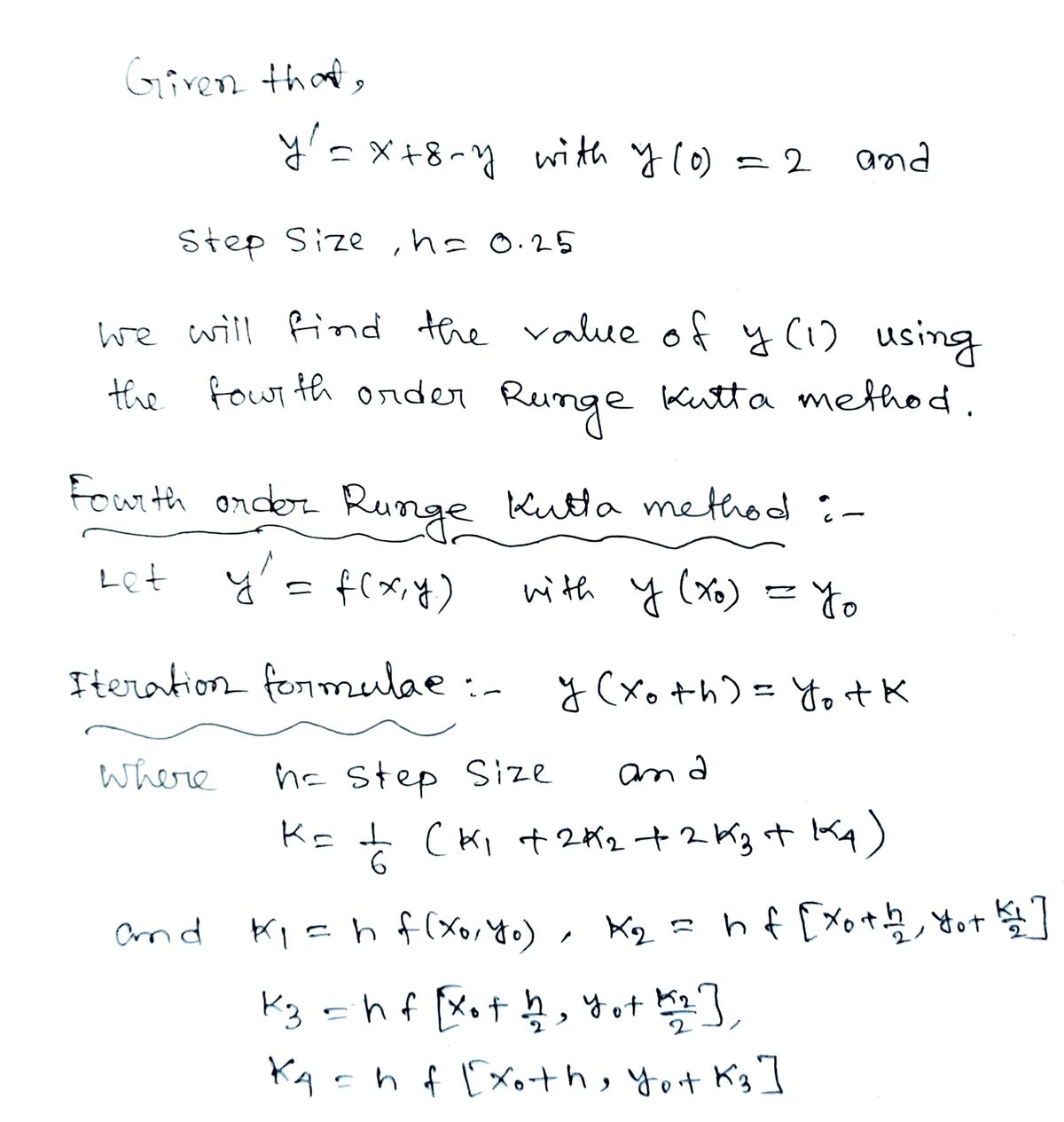Use the fourth-order Runge-Kutta subroutine with h = 0.25 to approximate the solution to the initial value problem below, at x = 1. Using the Taylor method of order 4, the solution to the initial value problem, at x = 1, is (1)=6.102388. Compare your approximation with the one of obtained using the Taylor method. Note whether or not is bounded. y'=x+8-y, y(0) = 2 of Let y'=f(x,y). Findy and determine whether or not it is bounded on the vertical strip S={(x,y): 0
Use the fourth-order Runge-Kutta subroutine with h = 0.25 to approximate the solution to the initial value problem below, at x = 1. Using the Taylor method of order 4, the solution to the initial value problem, at x = 1, is (1)=6.102388. Compare your approximation with the one of obtained using the Taylor method. Note whether or not is bounded. y'=x+8-y, y(0) = 2 of Let y'=f(x,y). Findy and determine whether or not it is bounded on the vertical strip S={(x,y): 0
Advanced Engineering Mathematics
10th Edition
ISBN:9780470458365
Author:Erwin Kreyszig
Publisher:Erwin Kreyszig
Chapter2: Second-order Linear Odes
Section: Chapter Questions
Problem 1RQ
Related questions
Question

Transcribed Image Text:Use the fourth-order Runge-Kutta subroutine with h = 0.25 to approximate the solution to the initial value problem below, at x = 1. Using the Taylor method of order 4, the solution to the initial value problem, at x = 1, is (1)=6.102388. Compare your approximation with the one
Əf
dy
obtained using the Taylor method. Note whether or not
is bounded.
y'=x+8-y, y(0)=2
Let y'=f(x,y). Find
af
OA. y (x,y)=[
of
and determine whether or not it is bounded on the vertical strip S = {(x,y): 0<x<1, -∞<y<∞). Select the correct choice below and fill in the answer box to complete your choice.
Əy
is bounded.
af
OB. y(x,y)= is not bounded.
Use the fourth-order Runge-Kutta subroutine with h = 0.25 to approximate the solution to the initial value problem at x = 1.
K(1) =
(Round to six decimal places as needed.)
C
Let (x) denote the actual solution. Which approximation is better? Select the correct choice below and fill in the answer box to complete your choice.
(Round to six decimal places as needed.)
O A. The Taylor approximation is better, because the error is $T(1)-(1)| = |
OB. The Runge-Kutta approximation is better, because the error is |K(1)— Þ(1)| = .
Expert Solution
Step 1

Trending now
This is a popular solution!
Step by step
Solved in 8 steps with 8 images

Recommended textbooks for you

Advanced Engineering Mathematics
Advanced Math
ISBN:
9780470458365
Author:
Erwin Kreyszig
Publisher:
Wiley, John & Sons, Incorporated

Numerical Methods for Engineers
Advanced Math
ISBN:
9780073397924
Author:
Steven C. Chapra Dr., Raymond P. Canale
Publisher:
McGraw-Hill Education

Introductory Mathematics for Engineering Applicat…
Advanced Math
ISBN:
9781118141809
Author:
Nathan Klingbeil
Publisher:
WILEY

Advanced Engineering Mathematics
Advanced Math
ISBN:
9780470458365
Author:
Erwin Kreyszig
Publisher:
Wiley, John & Sons, Incorporated

Numerical Methods for Engineers
Advanced Math
ISBN:
9780073397924
Author:
Steven C. Chapra Dr., Raymond P. Canale
Publisher:
McGraw-Hill Education

Introductory Mathematics for Engineering Applicat…
Advanced Math
ISBN:
9781118141809
Author:
Nathan Klingbeil
Publisher:
WILEY

Mathematics For Machine Technology
Advanced Math
ISBN:
9781337798310
Author:
Peterson, John.
Publisher:
Cengage Learning,

